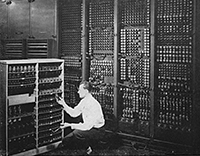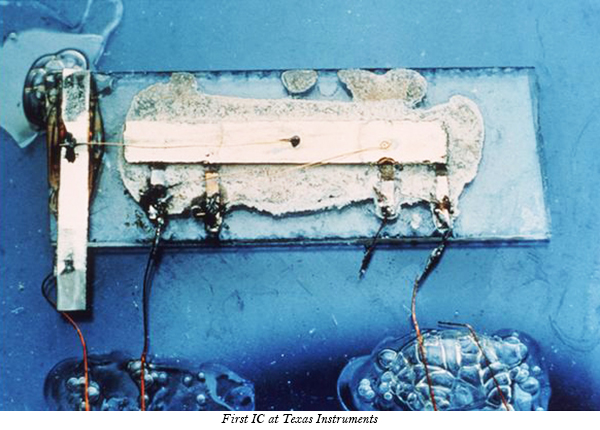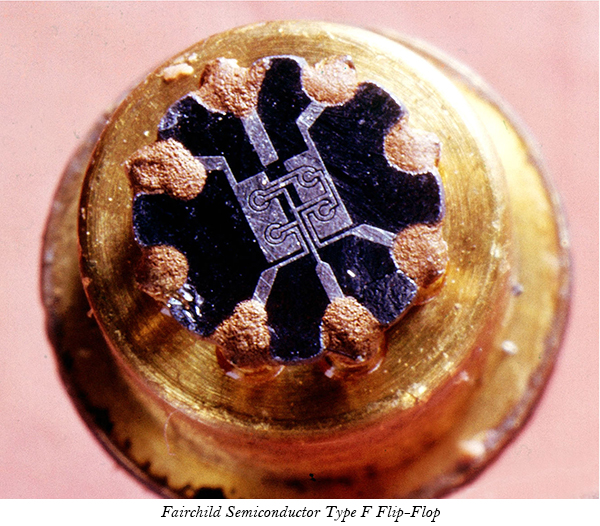If you pluck a hair from your head and divide it in two, the cross-sectional area you will see – or perhaps you won't see because it is so tiny – this area can house thousands of electronic transistors that can intelligently connect together to build a complex circuit. This scale of manufacturing is so sensitive that even a speck of dust or a microscopic entity like bacteria can corrupt the entire circuit. Truly incredible are the advances in the science and art of circuit integration, but they are also a daily activity for hundreds of semiconductor companies around the world, where hundreds of thousands of engineers work and brainstorm.

Fig. 1: Image of the previous computer
What is an everyday matter today was only a theoretical possibility half a century ago. Remember, there was a time when computers were the size of a large room. The more complex a computer was, the more space it needed to house its vacuum tube circuit, and the lower the reliability of the circuit became. These were the daily unsolvable problems of the electronics industry. How we get out of the complex maze of thick, heavy vacuum tubes and into today's nanoscale integration is the journey that depends on a single, defining invention: the invention of Integrated Circuits; and guided by a single, ancient saying: necessity is the mother of invention.
What necessitates this invention is the infamous problem of the “tyranny of numbers”.
The Tyranny of Numbers
As early as the early 1950s, the Bell laboratory developed small, reliable transistors. It was thought that if the size of electronic components were reduced, all problems related to volume would be solved and it would be easy to create complex circuits. There were, however, unforeseen problems that accompanied miniaturization.
A circuit is not just about its components, but also about their connections. And for any circuit to work, connections must be stable – it is through them that electrons (currents) flow from one component to another. Connections are the channel of interaction. And an error-prone channel would make the entire circuit defunct.
At that time, circuits were made by hand – workers soldered the different components to vacuum tubes with metal wires. As component sizes decreased, it became apparent that manually assembling the tiny semiconductor components would lead to faulty connections. Errors were inevitable and there was no way to maintain a quality check.
In 1958, IT had a new employee who had not yet taken his vacation. Jack Kilby should be working. So, to make the most of his time, he dove head first into the central problem of the day and came up with a brilliant solution.
The second problem was the size. A complex circuit depended on speed. If the metal wires were too long, the electrical signals would not move quickly enough. This would make the circuits inefficient.
These two problems together were the problems of numbers; infamously called The Tyranny of Numbers. In a nutshell, the problem stated that any advanced circuit would have so many parts and connections that it would not be practical to do so.
The prophecy of a solution: no connecting wires
British radio engineer Geoffrey Dummer approached these problems optimistically in 1942. He said: “With the advent of the transistor and work on semiconductors in general, it now seems possible to imagine electronic equipment in a solid block without connecting wires. . The block may consist of layers of insulating materials, conductors, rectifiers and amplifiers, the electrical functions being connected by cutting areas of the various layers.”
He was “the prophet of integrated circuits” – the one who could predict their arrival in the near future. He had prophesied a theoretical solution to the obvious problem: connectionless circuits. But it was in the hands of two engineers, working separately in different laboratories at the same time and in the same country, that the prophecy began to take physical form.
Jack Kilby's Masterpiece – The Monolithic IC
In the summer of 1958, Texas Instruments closed for a two-week company-wide vacation. This was something they did every year. In 1958, however, they had a new employee who had not yet earned his vacation. Jack Kilby should be working. So, to make the most of his time, he dove head first into the central problem of the day and began looking for a replacement for the practical methods of circuit miniaturization. Due to his previous experience at Centralab in Milwaukee, Kilby was familiar with the “tyranny of numbers” problem. He realized that the only commodity a company could manufacture cheaply was a semiconductor. Therefore, he concluded, all components of the circuit should be made of the same material from which semiconductors are made. Nobody had thought of this before.

Fig. 2: Image of the world's first integrated circuit (IC)
Kilby created some sketches for this process. When the vacation was over, he showed the sketches to his manager Willis Adcock. Adcock thought they were brilliant but wasn't sure about them. He asked Kilby to go ahead anyway and build a working silicon circuit. This proved to be a significant management decision as on 28 August 1958, Kilby showed a successfully working circuit to Adcock and he immediately received a green flag for his project. In his next circuit, he integrated all electronic and electrical components into a single rod of germanium.
This device was tested and worked exactly as Kilby had predicted. He thus solved one of the most perplexing problems associated with miniaturization. Once his invention was accepted by people in the industry, everything was set to revolutionize electronic technology.
“This thought led me to the conclusion that semiconductors were all that was really needed – that resistors and capacitors (passive devices), in particular, could be made from the same material as active devices (transistors). I also realized that because all the components could be made from a single material, they could also be made in situ and interconnected to form a complete circuit,” Kilby recalled in an article titled “Invention of the IC” in 1976.
He added: “What we didn't realize at the time was that the integrated circuit would reduce the cost of electronic functions by a factor of a million to one. Nothing had ever done this before.”
The three problems of microelectronics
By the way, connections weren't the only area of concern. There were, in fact, three distinct and fundamental issues for the miniaturization of electronic components. In 1958, Torrek Wallmark described them as:
1. Integration Problem: In 1958, the various electronic components could not be integrated into a semiconductor crystal because the alloy was not suitable for IC. How do you integrate them?
2. Isolation Problem: At the atomic level, how can we ensure that different components do not overlap? How do you keep them electrically isolated in a semiconductor crystal?
3. Connection Problem: How to connect microelectronic components reliably? The only method available at that time was extremely expensive and time-consuming, using gold wire.
“If the automobile industry advanced as quickly as the semiconductor industry, a Rolls Royce would get half a million miles per gallon and it would be cheaper to throw it away than park it.”
Solutions were soon found. Three companies invented them separately and held the main patents for each of the three problems. Although the Sprague Electric Company decided not to develop ICs, Texas Instruments, where Kilby worked, seemed to restrain itself. Fairchild Semiconductor, however, combined the different techniques required for commercial manufacturing of monolithic ICs and moved forward. At Fairchild resided another genius mind, without whose pioneering efforts ICs would have remained a theoretical concept, a possibility, for a long time. The genius was the co-founder of Fairchild, who would go on to co-found the electronics giant Intel.
Robert Noyce's Pioneering Efforts
Robert Noyce, individually, and just six months after Kilby, came up with the idea for the integrated circuit at Fairchild. Noyce had solved many practical problems that existed in Kilby's circuit, especially the problem of component interconnection. He added metal as a final layer and then removed some of it so that wires were formed. By getting rid of “flying wire” connections, Noyce introduced a practical method of mass manufacturing Jack Kilby's solid circuits.
In July 1959, Noyce filed his “semiconductor device structure and conductor” patent, and then a group of expert engineers at Fairchild made the first working monolithic ICs in May 1960.
Thus began the improvements that made the IC suitable for commercial production.
Micro Chip's Early Success
As with all cutting-edge technologies, the integrated circuit first found a buyer in the military. As early as 1961, the first computer using silicon chips was manufactured for the Air Force and applied to the Minuteman Missile in 1962. As there was a need for a product that could make everyone see the importance of IC technology (and help make it popular). ), Kilby designed a calculator that was as powerful as the huge desktop electromechanical calculators of the time, but small enough to be held in the palm of the hand. This reduction in size led to the huge success of its calculator – one of the first commercial applications of IC technology – and paved the way for technology integration in the production space.
Patents for the Integrated Circuit
Both Kilby and Noyce are considered inventors of the IC. If one of them came up with a revolutionary new idea for integration, the other made sure that the practical problems associated with them did not prevent the idea from reaching its potential. But things weren't exactly perfect at the two companies these genius engineers worked for. Fairchild and TI file patents in 1959. Jack Kilby and Texas Instruments received U.S. Patent No. 3,138,743 for miniaturized electronic circuits and Robert Noyce and Fairchild Semiconductor Corporation received U.S. Patent No. 2,981,877 for a silicon-based integrated circuit . This was followed by patent litigation for a decade.
Before things could get worse, the two parties reached a commercial solution. And the two inventors received their due. Kilby and Noyce were awarded the National Medal of Science in 1979. Noyce said very humbly: “I have no doubt that if this invention had not appeared at Fairchild, it would have appeared elsewhere in the very near future. It was an idea whose time had come and the technology had developed to the point where it was viable.”

Fig. 3: Image of the Fairchild Semiconductor Type F flip-flop
The Evolution of the Integrated Circuit
We've come a long way since Jack Kilby developed the first IC prototype. The transistors on the chips are now around 90 nm: to give another measure of achievement, hundreds of these transistors can be inserted into a single red blood cell. Gordon Moore, an integrated circuit pioneer and founder of Intel, once said, “If the automobile industry advanced as quickly as the semiconductor industry, a Rolls Royce would get half a million miles per gallon and it would be cheaper to throw it away.” . far than parking it. This rapid growth in miniaturization techniques was made possible by Kilby's vision of the first prototype and Noyce's insightful practical improvements.
Recognizing the same, the Nobel committee awarded Jack Kilby the Nobel Prize in Physics in the year 2000 – the highest honor any human being can receive. Robert Noyce had already passed away and was unable to share the prize. His contributions, however, were never challenged. The credit for inventing the IC goes to the two engineers jointly.
Thanks to the exponential development of semiconductor technology, we are rapidly advancing as a civilization. Every six months, our computers become more powerful and cheaper, and hundreds of innovations happen every day in the computing space. The invention of the IC undoubtedly changed the course of human history, as the IC is at the heart of every modern electronic product on the planet.

